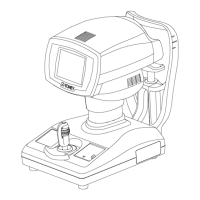
Do you have a question about the Tomey RC-5000 and is the answer not in the manual?
| Measurement Range of Axis | 0 to 180° |
|---|---|
| PD Measurement Range | 45 to 85 mm |
| Display | 5.7-inch color LCD |
| Printer | Built-in thermal printer |
| Power Supply | AC 100-240V, 50/60Hz |
| Measurement Range of Refraction (Sphere) | -25.00 to +22.00 D |
| Measurement Range of Refraction (Cylinder) | 0.00 to ±10.00 D |
| Measurement Range of Keratometry (Radius of Curvature) | 5.0 to 10.00 mm |
| Measurement Range of Keratometry (Corneal Refraction) | 33.75 to 67.50 D |
| Pupil Diameter Measurement Range | 2.0 to 8.0 mm |
| Weight | 19 kg |
| Measurement Time | 0.3 seconds |
Essential safety guidelines for installation and operation to prevent injury and equipment damage.
Instructions for checking received items after unpacking the instrument.
Definitions of technical terms and abbreviations used in the manual.
Overview of the instrument's basic functions and measurement workflow.
Identifies and describes controls and parts on the operator's side of the instrument.
Identifies and describes parts that the patient interacts with or that are relevant to the patient.
Details the display elements and information shown on the instrument's monitor during operation.
Explains how to use the joystick for precise alignment and adjustment of the instrument head.
Describes the touch panel functionality for aligning the measurement head and positioning the target.
Information on connecting external equipment via the RS-232C port for data output.
Crucial steps and precautions for correctly installing the auto refkeratometer.
Procedures to follow before starting any eye measurement, including startup and alignment.
Detailed steps for performing various measurement modes like refractive power and corneal curvature.
Instructions on how to print measurement results and configure print settings.
How to view and manage measurement data stored in the instrument's memory.
Procedures for transferring and managing patient data using the Tomey Link system.
How to input patient identification data for measurement and data transfer.
Guide to configuring various measurement parameters and settings for optimal performance.
Instructions for making temporary adjustments to measurement settings for specific cases.
How to change the display language of the instrument's interface.
Explanation of the refractive index values used for corneal power calculations.
Details on how residual astigmatism is calculated and its relation to contact lens fitting.
Terms and conditions of the product's limited warranty coverage.
Information regarding the expected operational lifespan of the instrument.
Procedures for checking the instrument's functionality using a model eye before use.
Recommended daily, weekly, or monthly tasks to keep the instrument in good working order.
Step-by-step guides for replacing consumables like printer paper, fuses, and chin rest paper.
Guidelines for safely storing the instrument when not in use to prevent damage.
Instructions for the proper disposal of the instrument's packaging and internal cells.
Solutions for issues where the instrument's display or power indicators are not functioning.
Common problems related to the built-in printer and their resolutions.
Explanations and remedies for various error codes and messages displayed by the instrument.
Information on ordering specific printer paper rolls for the RC-5000 model.
Details on how to purchase and use chin rest paper for hygiene and comfort.
Information on specifying and ordering replacement fuses for the instrument.
Overall technical specifications and parameters of the RC-5000 instrument.
Description of normal operating noises produced by the instrument during various functions.
Recommended ambient temperature, humidity, and pressure for instrument operation.
List of relevant safety and performance standards the instrument complies with.
Information regarding the instrument's compliance with electromagnetic compatibility standards.
